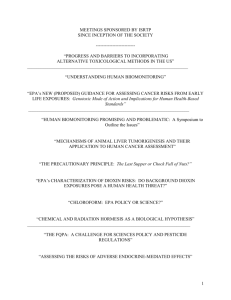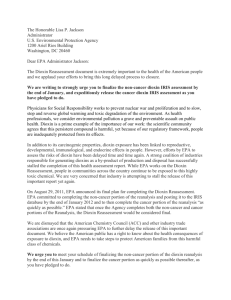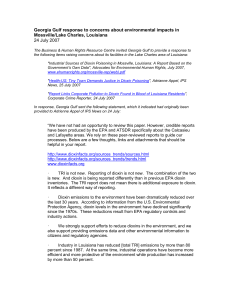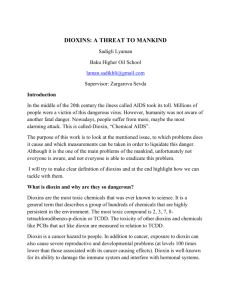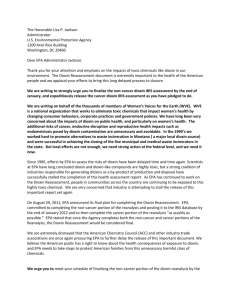The Green Guide July/August by Molly Rauch, M.P.H.
advertisement
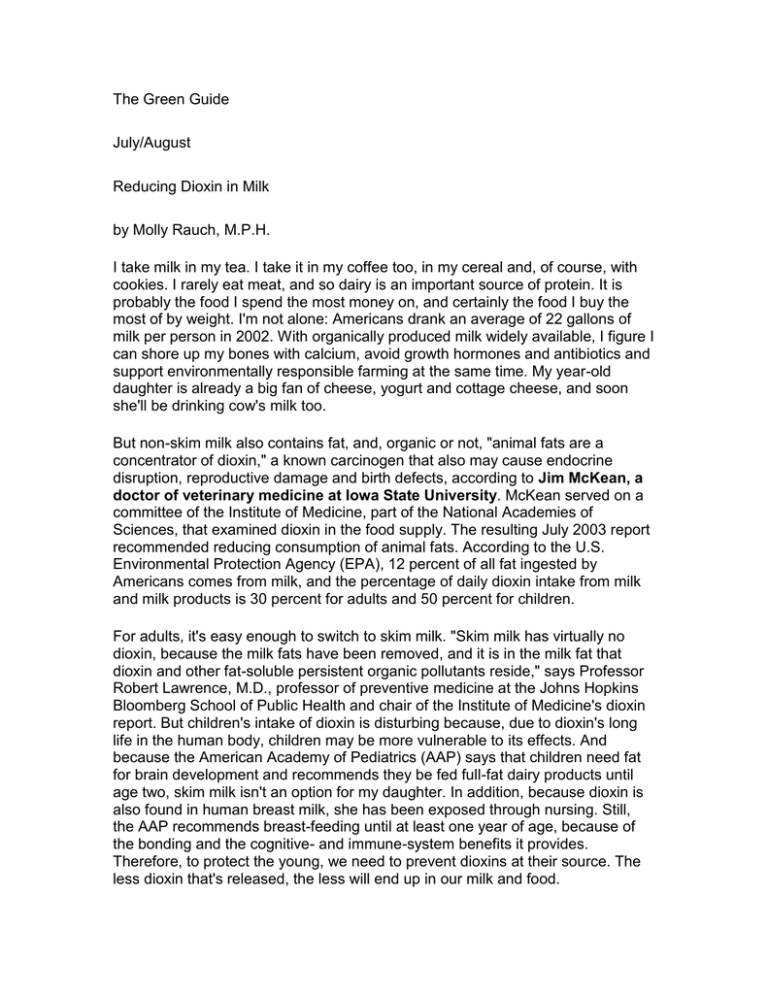
The Green Guide July/August Reducing Dioxin in Milk by Molly Rauch, M.P.H. I take milk in my tea. I take it in my coffee too, in my cereal and, of course, with cookies. I rarely eat meat, and so dairy is an important source of protein. It is probably the food I spend the most money on, and certainly the food I buy the most of by weight. I'm not alone: Americans drank an average of 22 gallons of milk per person in 2002. With organically produced milk widely available, I figure I can shore up my bones with calcium, avoid growth hormones and antibiotics and support environmentally responsible farming at the same time. My year-old daughter is already a big fan of cheese, yogurt and cottage cheese, and soon she'll be drinking cow's milk too. But non-skim milk also contains fat, and, organic or not, "animal fats are a concentrator of dioxin," a known carcinogen that also may cause endocrine disruption, reproductive damage and birth defects, according to Jim McKean, a doctor of veterinary medicine at Iowa State University. McKean served on a committee of the Institute of Medicine, part of the National Academies of Sciences, that examined dioxin in the food supply. The resulting July 2003 report recommended reducing consumption of animal fats. According to the U.S. Environmental Protection Agency (EPA), 12 percent of all fat ingested by Americans comes from milk, and the percentage of daily dioxin intake from milk and milk products is 30 percent for adults and 50 percent for children. For adults, it's easy enough to switch to skim milk. "Skim milk has virtually no dioxin, because the milk fats have been removed, and it is in the milk fat that dioxin and other fat-soluble persistent organic pollutants reside," says Professor Robert Lawrence, M.D., professor of preventive medicine at the Johns Hopkins Bloomberg School of Public Health and chair of the Institute of Medicine's dioxin report. But children's intake of dioxin is disturbing because, due to dioxin's long life in the human body, children may be more vulnerable to its effects. And because the American Academy of Pediatrics (AAP) says that children need fat for brain development and recommends they be fed full-fat dairy products until age two, skim milk isn't an option for my daughter. In addition, because dioxin is also found in human breast milk, she has been exposed through nursing. Still, the AAP recommends breast-feeding until at least one year of age, because of the bonding and the cognitive- and immune-system benefits it provides. Therefore, to protect the young, we need to prevent dioxins at their source. The less dioxin that's released, the less will end up in our milk and food. Dioxin is an industrial byproduct that enters the environment through paper bleaching, incineration and other industrial processes. When dioxin emerges from an incinerator smokestack, it later rains down on grass, gets eaten by a ruminant (cow, goat or sheep) and moves into the animal's fat—and her milk. Much of the dioxin released into the air comes from the burning of plastics, particularly vinyl products, both in backyard waste pits and in municipal and medical-waste incinerators. Already, thanks to improvements in design and operating conditions (higher temperatures mean less dioxin), as well as the closing of some incinerators, our exposure to dioxin may be on the decline. The EPA has found that between 1996 and 2000, dioxin in milk declined by 50 percent. While levels may be declining for some, however, it's not necessarily the case for all. John Schaum, M.S., an environmental engineer at the EPA, points out that "milk is one of the few foods distributed locally," so there may be regional differences in its dioxin levels. The EPA's latest study pooled nationally collected milk samples to compare North, South, East and West, and found little difference across these broad regions. But Jean Richardson, Ph.D., professor emerita in Environmental Studies at the University of Vermont, has compared Vermont milk to Wisconsin milk and found that "Wisconsin had much higher levels" of dioxin in milk due to weather patterns and waste incineration. "Farmers feel that they are victims of the air pollution," Richardson says. Even where dioxin levels are comparatively low—at what the EPA refers to as "background levels"—some scientists are concerned. "This chemical has biological activity at extraordinarily low levels," says Ted Schettler, M.D., science director of the Science and Environmental Health Network. The developing fetus is highly sensitive to dioxin, he says, citing evidence of "a correlation between levels of dioxin a fetus is exposed to and the strength of the developing immune system." Problems Increased ear infections and diminished response to vaccinations have been observed after higher levels of prenatal dioxin exposure in one group of healthy Dutch children. In addition to immune-system problems, "the organ system that is among the most sensitive" to the effects of dioxin at low levels "is the developing reproductive tract," Schettler says. He points to studies showing a link between endometriosis, a painful disease of the uterine lining, and dioxin exposure in rhesus monkeys. Other doctors highlight the risk of injury to the brain. According to Lawrence, "The developing fetus and infant are at risk for neurologic injury from dioxin, with developmental delays and other central-nervous-system problems." This doesn't mean we should panic. As Schettler says, "Would I call this a publichealth emergency? No." Lawrence thinks that despite dioxin's ability to accumulate in the body, current levels in people are low, just not low enough. "By prudent choice of low-fat foods, girls and women of child-bearing age can reduce the risk further," he says. I am one of those "women of child-bearing age," and my baby daughter will be one in the blink of an eye. Despite my concerns about the health effects of dioxin, I am not planning to eliminate milk from my diet. I will go ahead and put (skim) milk in my granola before breast-feeding my daughter. And I'll work for the day when she can drink a glass of dioxin-free milk.
